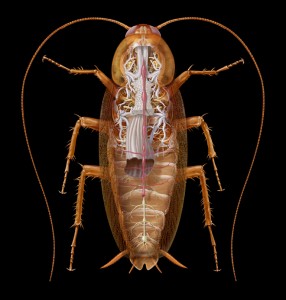An Instructional Tool for the Study of Insect Anatomy
Project Developers:

Joseph V. McHugh
Professor, Department of Entomology
University of Georgia
mchugh(at)uga.edu
Eugene N. Wright
Professor, Lamar Dodd School of Art
University of Georgia
gwright(at)uga.edu
Mission:
The objective of the Virtual Roach Project is to develop an exciting, interactive tool for instruction on the subject of insect morphology.
Project Summary:
The Virtual Roach is a free instructional package comprising a collection of graphics, text and a glossary of terms. The MS-Windows based interface for the system links the material in a manner permitting interactive study of the anatomy of the American Cockroach (Periplaneta americana (Linnaeus)) through a virtual dissection.
Background:
Insects are a major component of every non-marine ecosystem on earth, placing Entomology at the core of agricultural, environmental and life science curricula. Morphology is perhaps the most fundamental element of entomological studies because a basic knowledge of anatomy is a logical prerequisite to studies of taxonomy, physiology, behavior and biology. Unfortunately, this important subject is difficult to teach in a stimulating manner. The nature of morphological study requires exposure to a vast number of new structures and terms. The typical instructional material used for this subject consists of reproductions of illustrations from a few classic texts and laboratory dissections. Though illustrations from the basic literature are often technically superb, they are monochromatic, flat, and not particularly engaging. It is difficult to provide dynamic instruction using only this material for visuals. Hands-on dissections are more stimulating, but require considerable time, supplies and an appropriately equipped facility. It is usually not practical to use actual dissections in lectures because they require a great deal of preparation time and are too clumsy and slow for a smooth presentation. For some courses and workshops, dissections are simply not possible due to limitations of time, equipment, or proper facilities.
The interface for The Virtual Roach links morphological terms with an extensive image archive, including scientific illustrations, scanning electron micrographs, photomicrographs and video clips. Images are arranged in a manner permitting a virtual dissection of the American Cockroach, Periplaneta americana. Information on the natural history and behavior of roaches are cross-linked throughout the program, reflecting inseparable nature of form and function. As an autotutorial module, the Virtual Roach can function as a freestanding reference, an interactive bench-top guide, a pre-lab introduction, or a post-lab review tool. Because the extensive collection of colorful images and text are also available for quick reference from an index of more than 400 terms, the program can serve as a powerful visual aid to augment lecture-format instruction as well.
The Humble subject: The American Cockroach,Periplaneta americana (Linnaeus), is an ideal subject for the study of insect anatomy. It is a familiar insect to the public and has been studied extensively by the scientific community. Because the anatomy of roaches and closely related orthopteroid taxa has been studied extensively, basic literature is available, greatly reducing the time required for the authors to interpret structures for this project. Blattid anatomy represents a relatively generalized insectan form; therefore students will be able to identify and homologize the anatomy of other taxa more easily. The American Roach is also a perfect species for complementary laboratory instruction due to their large size, relatively thin cuticle, and availability. Teachers can easily collect and rear P. americana or purchase specimens from biological supply companies which provide an inexpensive and dependable source of living stock and preserved material.
Acknowledgements:
Participants:
All participants were active faculty, staff, or students at the University of Georgia during the period of participation.
Project Coordinators:
Joseph V. McHugh, Professor, Dept. of Entomology
Eugene N. Wright, Professor, School of Art
Student Participants:
–Department of Entomology: Mark Abney, Cheri Abraham, Petty Bennet, Erica Chiao, Juanita Forrester, Gregory Hodges, Amanda Hall Hodges, Ta-I Huang, Tatiana G. Kiselyova, Corey Lewis, Jordan Magee, Shakunthala Nair, Floyd W. Shockley, Erich H. Tilgner
-Scientific Illustration Program: Tony Baselici, Brad Guilland, Andy Rekito
Formal Evaluators:
Instructional Technology Evaluator: Priya Sharma, Department of Instructional Technology
Interface Evaluator: Amy L. Edwards, Georgia Museum of Natural History
Content Evaluator: Robert Matthews, Department of Entomology
Volunteer testers: Erika Bilger, Elizabeth Glenn, David Jenkins, Tatiana Kiselyova, Anna Majzlik, Terry McHugh, Daniel Potucek, Glen Ramsey, Dawn Stanek
Support: The Virtual Roach Project was supported by a grant (#GEO9803572) from the United States Department of Agriculture (USDA) through the Cooperative State Research, Education, and Extension Service (CSREES) under its Higher Education Programs (HEP). Additional support was provided by the following units at The University of Georgia: Department of Entomology, Georgia Museum of Natural History, and College of Agricultural and Environmental Sciences.
HOW TO CITE THIS WORK:
McHugh, J.V. and Wright, G.N. (2009) The Virtual Roach: An Instructional Tool For The Study of Insect Anatomy (vers. 2009-1)[software]. Athens, Georgia. Available from https://site.caes.uga.edu/mchughlab/research/the-virtual-roach/
TO REQUEST THE VIRTUAL ROACH:
– – – > click here < – – –
FAQ
We started a FAQ page to help people to work around the outdated program interface. It is located at the link below.
DEMONSTRATION VIDEOS:
Contact:
Page maintained by Joe McHugh.
Please send questions/comments to: mchugh(at)uga.edu



